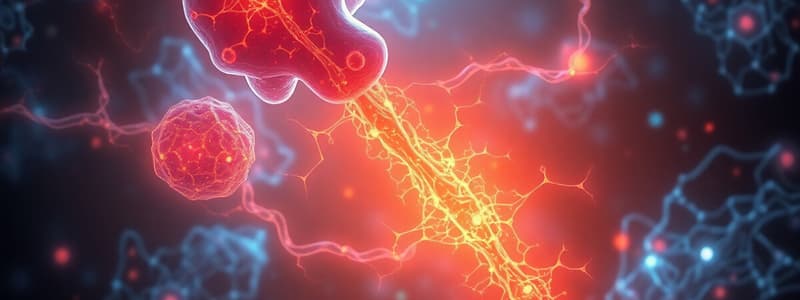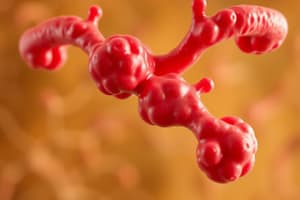Podcast
Questions and Answers
What is the primary source of growth hormone (GH)?
What is the primary source of growth hormone (GH)?
- Adrenal gland
- Thyroid gland
- Anterior pituitary (correct)
- Hypothalamus
Growth hormone stimulates growth during fetal life.
Growth hormone stimulates growth during fetal life.
False (B)
What are the two neurohormones from the hypothalamus that regulate GH secretion?
What are the two neurohormones from the hypothalamus that regulate GH secretion?
GHRH and GHIH
GH mainly controls metabolism in __________.
GH mainly controls metabolism in __________.
Which of the following factors is not known to increase GH secretion?
Which of the following factors is not known to increase GH secretion?
Match the roles of growth hormone with their descriptions:
Match the roles of growth hormone with their descriptions:
How does Growth Hormone affect glucose utilization in tissues?
How does Growth Hormone affect glucose utilization in tissues?
IGF1 has a shorter half-life than GH.
IGF1 has a shorter half-life than GH.
What is the primary effect of IGF1 on chondrocytes?
What is the primary effect of IGF1 on chondrocytes?
Insulin and glucagon have similar effects on glucose metabolism.
Insulin and glucagon have similar effects on glucose metabolism.
What condition results from overproduction of GH after puberty?
What condition results from overproduction of GH after puberty?
Insulin is produced as a preprohormone, which is converted to ___ before secretion.
Insulin is produced as a preprohormone, which is converted to ___ before secretion.
Match the hormone with its respective function:
Match the hormone with its respective function:
What is a potential risk associated with infant absorption of GH and IGF from bovine sources?
What is a potential risk associated with infant absorption of GH and IGF from bovine sources?
Dwarfism can be caused by a lack of IGF1 action on hair follicle differentiation.
Dwarfism can be caused by a lack of IGF1 action on hair follicle differentiation.
What is the role of bovine GH in milk production?
What is the role of bovine GH in milk production?
What is the major anabolic hormone of the body?
What is the major anabolic hormone of the body?
Glucagon stimulates the incorporation of glucose into glycogen in the liver and muscle.
Glucagon stimulates the incorporation of glucose into glycogen in the liver and muscle.
What effect does insulin have on blood glucose levels?
What effect does insulin have on blood glucose levels?
Insulin promotes the uptake of _______________ in addition to glucose.
Insulin promotes the uptake of _______________ in addition to glucose.
Which mechanism primarily regulates insulin and glucagon secretion?
Which mechanism primarily regulates insulin and glucagon secretion?
Match the hormones with their actions:
Match the hormones with their actions:
The sympathetic nervous system activates insulin secretion during stress.
The sympathetic nervous system activates insulin secretion during stress.
What condition is characterized by prolonged high blood glucose levels?
What condition is characterized by prolonged high blood glucose levels?
Flashcards are hidden until you start studying
Study Notes
Growth Hormone
- Growth hormone (GH), also known as somatotropin, is produced by the anterior pituitary gland.
- It promotes tissue and body growth in young animals, especially longitudinal growth until the skeleton is complete.
- In adults, GH primarily controls metabolism.
- GH does not stimulate growth during fetal life, this role is filled by Insulin Like Growth Factors (IGF1 and 2).
- The protein sequence of GH varies significantly between species, resulting in poor cross-reactivity.
Regulation of GH Secretion
- GH secretion is precisely regulated by hypothalamic neurohormones, GHRH and GHIH.
- GHRH stimulates GH release.
- GHIH (somatostatin) inhibits GH release.
- GH stimulates IGF1 production by the liver.
- IGF1, in turn, stimulates cartilage and bone growth, as well as milk production.
- GH regulates lipid and protein metabolism.
- The GH receptor belongs to the interleukin (cytokine) family.
Direct Effects of Growth Hormone
- GH affects most cells in the body.
- GH has a short half-life, around 20 minutes.
- GH is an anabolic hormone: like insulin, GH promotes protein synthesis.
- GH is also a catabolic hormone: unlike insulin, GH stimulates lipolysis and reduces lipogenesis in adipose tissue. This effect is crucial during fasting and at night.
- Lipolysis increases fatty acid production.
- GH decreases glucose utilization in most tissues, ultimately increasing blood glucose concentration.
Indirect Roles of GH via IGFs
- GH stimulates the synthesis of IGF1 and its binding proteins in the liver.
- Small amounts of IGF1 are also locally produced in muscle and adipose tissue.
- IGF1 is a polypeptide with a similar sequence in humans, pigs, and cattle.
- When bound to carrier proteins, IGF1 has a longer half-life than GH.
- IGF1 acts through its own tyrosine kinase receptors.
- IGF1 stimulates chondrocytes (cartilage cells) proliferation, leading to increased bone growth.
- IGF1 stimulates satellite cells in muscle, promoting muscle fiber growth.
- IGF1 stimulates amino acid uptake and protein synthesis.
GH and Lactation
- GH has no major role in mammary gland development.
- GH's impact on milk production is primarily mediated through metabolism and nutrient partitioning to the mammary gland for milk synthesis.
- Insulin usually directs nutrients towards lipogenesis in adipose tissue. GH has the opposite effect.
- Bovine GH (bST) can increase milk production by 10-40% in early and late lactation, respectively.
- A major concern for humans is that infants can absorb GH and IGF from the gut. IGF1 has a similar sequence in cattle and humans.
GH Pathologies
- Overproduction of GH is rare in animals:
- Before puberty (before skeleton formation): gigantism (increased longitudinal growth).
- After puberty (no more longitudinal growth): acromegaly, increased bone width and density, diabetes.
- In older dogs and cats: can be caused by a pituitary tumor.
- Lack of GH production: dwarfism.
- Primarily genetic defects of GH or GH receptor genes.
- Can be treated by injecting recombinant GH and IGF1.
- In dogs, dwarfs retain their puppy coat for extended periods due to a lack of IGF1 action on hair follicle differentiation.
Insulin and Glucagon
- The pancreas is both an endocrine and exocrine gland.
- The endocrine pancreas is composed of islets of Langerhans, scattered throughout the gland.
- Within the islets, beta cells (70%) secrete insulin, and alpha cells (20%) secrete glucagon.
- Insulin and glucagon have opposing effects on glucose metabolism.
Synthesis and Secretion of Insulin
- Insulin is produced as a preprohormone, which is converted to proinsulin.
- Before secretion, proinsulin is converted to active insulin by removing a connecting (C)-peptide.
- After secretion, insulin circulates freely with a half-life of 5-8 minutes and is degraded in target cells or the liver.
Synthesis and Secretion of Glucagon
- Glucagon is a 29-amino acid peptide produced as a preprohormone that is rapidly converted to active glucagon.
- After secretion, glucagon circulates freely with a half-life of 5 minutes and is metabolized in the liver and kidney.
Actions of Insulin
- Insulin is the primary anabolic hormone of the body.
- Through its tyrosine kinase receptor, insulin upregulates membrane glucose transporters, leading to increased cellular uptake of glucose in muscles and adipose tissue.
- Insulin stimulates the incorporation of glucose into energy storage molecules like glycogen in the liver and muscle, and triglycerides in adipose tissue.
- Insulin promotes the uptake of amino acids.
- These actions result in a decrease in blood glucose and amino acid levels.
Actions of Glucagon
- Glucagon has the opposite effect of insulin.
- Through its G-protein coupled receptor, glucagon activates enzymes responsible for glycogenolysis, releasing glucose from glycogen in the liver.
- Glucagon stimulates gluconeogenesis in the liver (synthesis of glucose).
- Glucagon stimulates the release of fatty acids from triglycerides in adipose tissue.
Regulation of Insulin and Glucagon Secretion
- The primary mechanism for regulating insulin and glucagon secretion is blood glucose concentration.
- Amino acid concentration also plays a smaller role in regulating secretion.
The Role of the Autonomic Nervous System
- During meals, the parasympathetic nervous system activates insulin secretion.
- The sympathetic nervous system inhibits insulin secretion and stimulates glucagon release, leading to "stress hyperglycemia."
Insulin and Diabetes Mellitus
- Diabetes is characterized by hyperglycemia (high blood glucose).
Studying That Suits You
Use AI to generate personalized quizzes and flashcards to suit your learning preferences.




